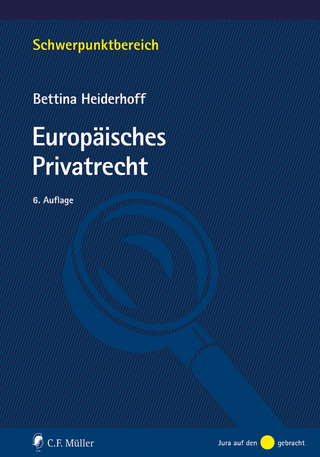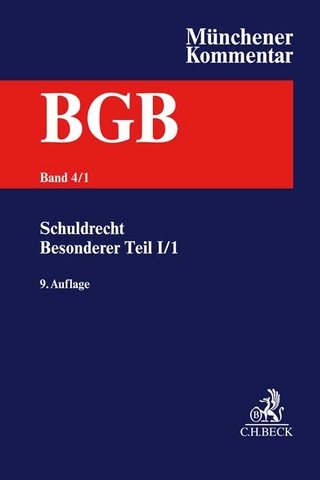
Advanced Introduction to Private International Law and Procedure
Edward Elgar Publishing Ltd (Verlag)
978-1-78643-678-8 (ISBN)
- Titel erscheint in neuer Auflage
- Artikel merken
Litigating disputes in international civil and commercial cases presents a number of special challenges. Which country's courts have jurisdiction, and where is it advantageous to sue? Given the international elements of the case, which country's law will the court apply? Finally, if a successful plaintiff cannot find enough local assets, what does it take to have the judgment recognized and enforced in a country with assets? The Advanced Introduction to Private International Law addresses these questions in a concise overview of the field.
Key features include:
Comparative overview of legal systems, contrasting Anglo-American common law and the civil law approach of the European Union
Written in a clear and engaging style
Addresses classic choice of law as well as international civil procedure
Problem-oriented presentation
Three parts presenting principal problems parties face in dealing with cases with an international dimension
Considers how the field could develop in the future.
Engaging and wide-ranging, this is an excellent introduction for students and academics new to the field and allows practitioners to master the core principles behind private international law quickly.
Peter Hay, L.Q.C. Lamar Professor of Law Emeritus, Emory University, School of Law, US
Contents:
Preface
I. Introduction: Basic Issues
1.1 “Private International Law”
1.2 The Elements of an “International Civil Case“
1.2.1 Sources
1.2.2 Issues of an International Case: Where to Litigate? What Law Applies?
1.2.3 Scope of Coverage
1.2.4 A Note on Terminology: The Different Meanings of “Jurisdiction”
1.3 Applicable Law And The Goals Of Conflicts Law
1.3.1 In General
1.3.2 Historical Notes
1.3.3 The Older European Model – Rule Orientation to Achieve “Conflicts Justice”
1.3.4 The American Conflicts “Revolution“
1.3.4.1 Excursus: The American Parallel Court System
1.3.5 Modern Approaches and Trend
1.3.5.1 United States
1.3.5.2 Europe
1.3.5.3 Elsewhere
1.4 Connecting Factors
PART I JUSIRDICTION TO ADJUDICATE
II. Forum-Selection Clauses
2.1Prorogation and Derogation
2.2 Some Limits
2.2.1 European Union Law
2.2.2 The Hague Convention
2.2.3 United States
2.2.4 Rejecting a Choice
2.2.5 The Law Applicable to a Forum-Selection Clause
2.3 One-sided Clauses
2.3.1 Adhesion Provisions
2.3.2 Clauses Excluding Recourse to Court
III. Jurisdiction Over Persons and Things
3.1 In Rem Jurisdiction
3.2 General Personal Jurisdiction
3.2.1 Exorbitant Rules
3.2.2 Jurisdiction Over Companies
3.3 Specific (or Special) Jurisdiction
3.3.1 What Contacts Confer Specific Jurisdiction?
3.3.2 “Stream-of-commerce” Jurisdiction
3.3.3 Weaker Party Protection in Contract in the EU
3.3.4 Weaker Party Protection in U.S. Law
3.4 Class Actions
3.5 Piercing the Corporate Veil for Jurisdiction
3.6 Jurisdiction in Domestic Relations Cases
3.6.1 Introduction
3.6.2 Marriage
3.6.3 Divorce
3.6.4 Child Custody
3.6.5 Maintenance, Child Support, and the like
3.6.6 Adoption
3.7 Dismissal for Lis Pendens or Forum Non Conveniens
3.7.1 Lis Alibi Pendens
3.7.2 Forum non conveniens
3.7.2.1 Blocking Statutes
3.8 Jurisdiction over Things – Actions in rem
3.9 Notice and Service
3.10 Taking Evidence Abroad
PART TWO: THE APPLICABLE LAW (CHOICE OF LAW)
IV. What Law Applies
4.1 Sources
4.1.1 Conventions
4.1.2 Federal-like (supranational) law: The Example of the European Union.
4.1.3 National (Domestic) Law: In General
4.2 Party Autonomy
4.2.1 Scope, Limits, Validity
4.2.2 Unusual Cases: Partial Choice of Law; “Floating Clauses”
4.3 How to Determine the Applicable Law in the Absence of a Party Choice: By Rule or Case-Specific Approach? – The Examples of Tort and Contract Conflicts Law
4.3.1 Civil Law
4.3.1.1. Example: European Union Conflicts Law in Tort and Contract
4.3.1.1.1 Contracts: Rome I
4.3.1.1.2 Torts and Other Non-Contractual Relationships: Rome II
4.3.2 Rule Orientation in the Common Law
4.3.2.1 Escape
4.3.3 The American “Conflicts Revolution” and Case-Specific Approaches
4.3.3.1 “Governmental Interest Analysis”
4.3.3.2 Better Law
4.3.3.3 The “Most Significant Relationship:” The Second Restatement
4.3.3.4 What Is American Conflicts Law Today, Especially in Tort and Contract?
4.3.4 Applicable Law for the Whole or only Part of the Case?
4.3.4.1 Characterization
4.3.4.2 Splitting a Case Into Its Component Issues: Dépeçage
4.3.5 Connecting Factors, Especially “Domicile” and “Habitual Residence”
4.3.5.1 Domicile
4.3.5.2 Habitual Residence
4.4 Renvoi
4.5 Special Aspects in American Law Regarding Time Limits; Damages
4.5.1 Time Limitations
4.5.2 Damages
4.6 Choice of Law in Other Areas Than Tort or Contract
4.6.1 Family Law
4.6.1.1 Capacity
4.6.1.2 Forms of Marriage
4.6.1.3 Marital Property
4.6.1.4 Support
4.6.2 Succession
4.6.2.1 Introduction
4.6.2.2 Procedural Issues
4.6.2.3 Applicable Law
4.6.2.4 European Union Law
4.6.2.5 Recognition
4.6.3 Corporate Entities
4.7 Forum Policy: Mandatory Norms and the Public Policy Exception
4.8 How to Determine the Content of Applicable Foreign Law?
4.8.1 How Does Foreign Law Become Applicable?
4.8.2 Determining the Content of and Applying Foreign Law
PART THREE: JUDGMENTS
V. Recognition and Enforcement of Foreign Jugments
5.1 Introduction
5.2 The Nature of the Foreign Decree
5.2.1 Finality
5.2.2 The Issuing Authority
5.2.3 Effect in Another State
5.3 Methods of Recognition – International Solutions
5.3.1 Treaties
5.3.2 Reciprocal Recognition Arrangements
5.3.3 The European Union’s “federal-type” Approach
5.3.4 The Lugano Convention
5.4 Recognition – National Law Approaches
5.4.1 The Civil Law Exequatur
5.4.2 Recognition Under Common Law
5.4.2.1 Recognition Within the United States
5.5 Defenses to Recognition and Enforcement
5.5.1 In General
5.5.2 Lack of Jurisdiction
5.5.2.1 Unified Systems – The United States and the EU
5.5.2.2 Testing Another Country’s Jurisdiction Under National Law
5.5.3 Notice
5.5.4 Conflicting Judgments
5.5.5 Public Policy
5.5.5.1 In General
5.5.5.2 Public Policy and révision au fond
5.5.5.3 Public Policy and Exporting Forum Values
5.5.6 No Remedy Available Locally
5.6 The Effect of a Recognized Judgment
5.6.1 The Res Judicata Effect on the Parties
5.6.2 Effect on Third Parties
5.7 Enforcement Mechanisms
5.7.1 Foreign-Country Judgments in the United States
5.7.2 Recognition Elsewhere
VI. An Assessment: Tasks, Developments, Trends
6.1 In General
6.2 Jurisdiction and Judgment Recognition of Civil and Commercial Judgments
6.2.1 Worldwide Harmonization
6.2.2 Regional Harmonization
6.2.3 National Law
6.3 Choice of Law
Appendix
Sources of European Union Law
Index
| Erscheinungsdatum | 02.09.2018 |
|---|---|
| Reihe/Serie | Elgar Advanced Introductions series |
| Verlagsort | Cheltenham |
| Sprache | englisch |
| Maße | 138 x 216 mm |
| Themenwelt | Recht / Steuern ► EU / Internationales Recht |
| Recht / Steuern ► Privatrecht / Bürgerliches Recht ► Internationales Privatrecht | |
| ISBN-10 | 1-78643-678-7 / 1786436787 |
| ISBN-13 | 978-1-78643-678-8 / 9781786436788 |
| Zustand | Neuware |
| Haben Sie eine Frage zum Produkt? |
aus dem Bereich



